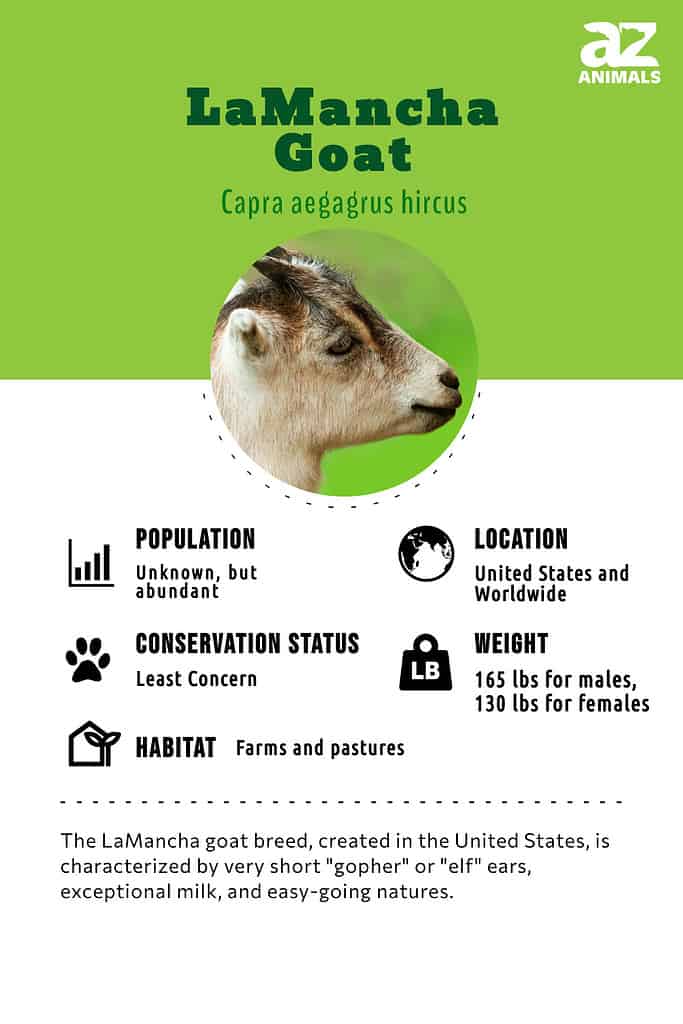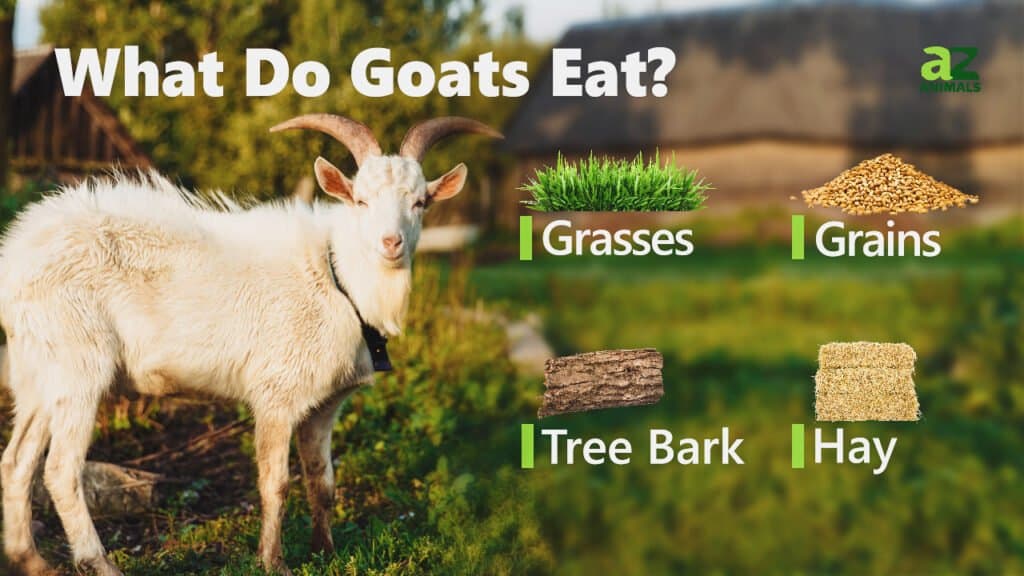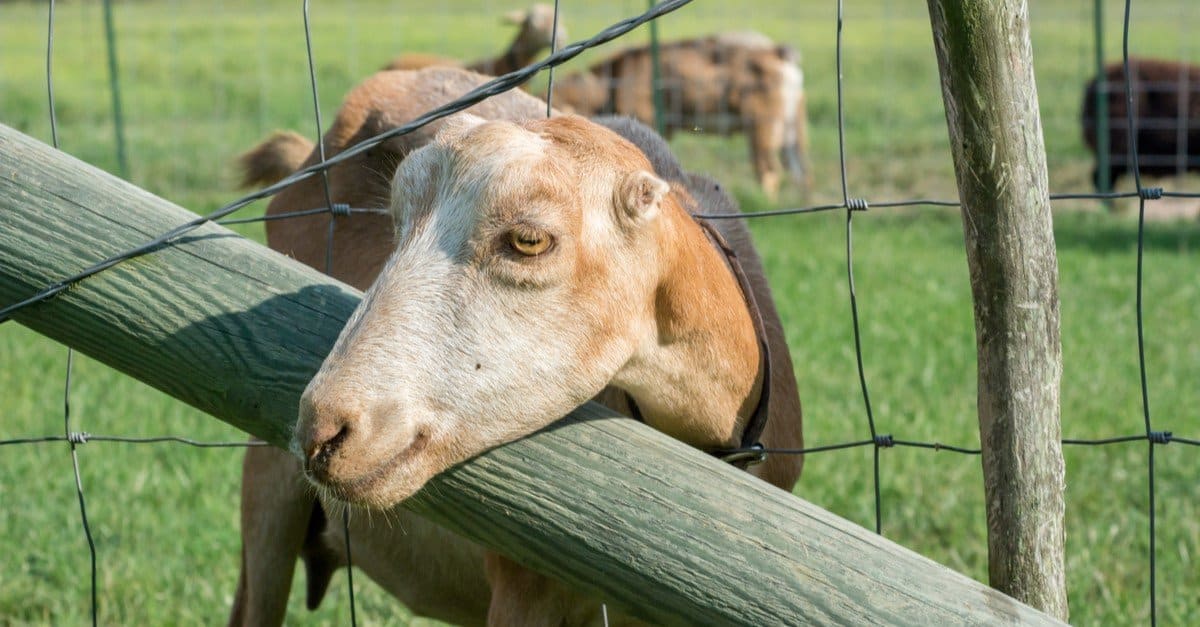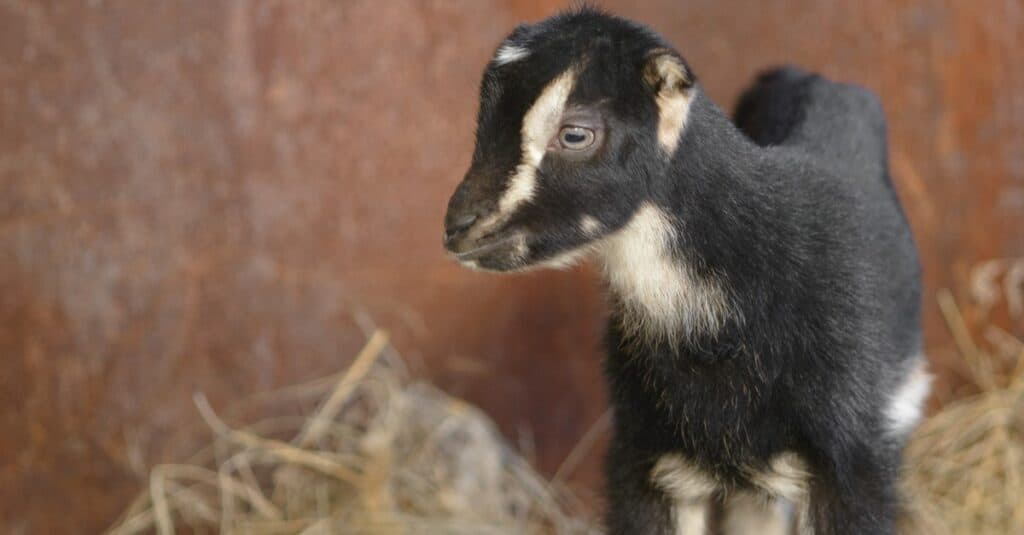LaMancha Goat
Capra aegagrus hircus
Have tiny ears named “gophers” or “elves”
Advertisement
LaMancha Goat Scientific Classification
- Kingdom
- Animalia
- Phylum
- Chordata
- Class
- Mammalia
- Order
- Artiodactyla
- Family
- Bovidae
- Genus
- Capra
- Scientific Name
- Capra aegagrus hircus
Read our Complete Guide to Classification of Animals.
LaMancha Goat Conservation Status
LaMancha Goat Facts
- Name Of Young
- Buckling, doeling, yearling
- Group Behavior
- Herd
- Fun Fact
- Have tiny ears named “gophers” or “elves”
- Estimated Population Size
- Unknown
- Biggest Threat
- Predators
- Most Distinctive Feature
- Tiny ears
- Other Name(s)
- American Lamancha
- Gestation Period
- 150 days
- Litter Size
- 1 to 3
- Habitat
- Farms, pastures
- Predators
- Wild dogs, cougars, wolves, raptors
- Diet
- Herbivore
- Common Name
- LaMancha Goat
- Number Of Species
- 1
- Location
- U.S.
- Group
- Artiodactyl
LaMancha Goat Physical Characteristics
- Color
- Brown
- Grey
- Black
- White
- Skin Type
- Hair
- Lifespan
- 7 to 10 years
- Weight
- Average 165 for males, 130 for females
- Height
- 2 to 3 feet
- Length
- 3 to 3 ½ feet
- Age of Sexual Maturity
- 9 months to 1 year
- Age of Weaning
- 3 weeks
View all of the LaMancha Goat images!
LaMancha goats are full-size dairy goats with a mild temperament.
Sometimes called American Lamancha or simply Lamancha, these goats are distinctive for their tiny ears. They are excellent milk producers, and their milk is highly nutritious.
For these reasons, LaMancha goats are among the most popular dairy goats in the U.S.

History
The origin of LaMancha goats goes back to 18th-century Spanish missionaries, who brought small, hardy goats they called “LaMancha” to what is now the U.S. However, the LaMancha goat breed was developed in the 20th century in the United States by breeders who were airming for an adaptable goat breed that could put out a high volume of milk. LaMancha goats were the result of crossing French Alpine, Spanish (Murcian), Toggenburg, Oberhasli, and Nubian goats.
Eula Fay Frey was an American woman who went into goat farming after learning about the health benefits of goat’s milk. In 1937, she purchased a dairy farm in California that had two short-eared goats in its herd of 130. They were the descendants of the original LaMancha goats from Spain.
Frey discovered that these short-eared goats were excellent milk producers. After crossbreeding them with other goats, she created a large, docile, productive breed she named the American LaMancha goat. The breed became an official goat breed in 1960.
5 Amazing Facts About LaMancha Goats!
- They were the first goat breed of U.S. origin.
- Their mini ears come in two types: “gopher” ears and “elf” ears.
- A LaMancha goat can produce ¾ of a gallon of milk a day.
- They don’t have a strong “goaty” smell.
- LaMancha goats make excellent pets.
Scientific Name
The LaMancha goat’s scientific name is Capra aegagrus hircus.
Types of LaMancha Goats
There are no subspecies of the Lamancha goat. There are generally two types of goats, as defined by their ears.
Gopher ears have a maximum length of 1 inch. Some are smaller and can have little or no cartilage. Gopher ears either thurn up or down. Only bucks with this kind of ear are eligible for registration. Elf ears have a max length of 2 inches, with the ends either turned up or down.
Appearance

The standout feature of a LaMancha goat is its tiny ears.
©souldust/Shutterstock.com
The LaMancha is a large goat that stands about 3 feet tall. Males have an average weight of 165 pounds, and females have an average weight of 130 pounds. LaManchas have round faces with sweet, docile expressions.
These goats have short, glossy fur and come in all the common colors you’ll find in most goats. They can be gray, black, brown, reddish-brown, or white. Many LaMancha goats have symmetrical spots in varying colors on their heads, and almost all have a black stripe along their backs.
The most noteworthy characteristic of a LaMancha is its tiny ears. Unusual for goats, these mini ears have their own classifications that depend on the ear’s size and shape.
- Gopher ear: This is an ear of one inch or smaller with little cartilage.
- Elf ear: This is a two-inch ear that sometimes flops down but usually stands straight up.
According to the American Dairy Goat Association, both ear types qualify a goat as an official member of the LaMancha breed.
Behavior

LaMancha Goats need good fencing because they will follow their caretakers faithfully.
©Jonathan_Densford/Shutterstock.com
These goats are hardy animals who can adapt easily to almost any climate. Like all goats, they must be protected from cold, wet weather because they can’t regulate their body temperatures if their hair gets wet.
They have easygoing, docile personalities that make them manageable for most farmers. Their intelligence and sweet temperament make them ideal pets. If they’re well treated, they can become attached to humans.
These sociable goats need good fencing because their affectionate natures will cause them to follow their human caretakers around rather than stay in their pasture. Fencing is also important to keep out predators.
These goats are sociable animals who like being in a herd or family group.
Goat Habitat
These goats live on farms. They are ideal for first-time farmers or small farms because their docile, friendly nature makes them easy to manage.
Although they are highly adaptable to different conditions, they need protection from wetness and cold. All LaMancha goats need a shelter like a barn or other protective structure.
Goat Diet

These goats eat brush, sticks, grasses, shrubs, and other natural vegetation. Most farmers supplement their goats’ diet with fresh hay. The best diet for all goats is 7% dietary crude protein and 50% dietary fiber.
Goats have a reputation for eating everything, but they prefer natural, healthy food. Good treats for LaMancha goats include fresh fruits like strawberries and watermelons, fresh vegetables, and black oil sunflower seeds.
Predators and Threats
These goats like to forage, but it’s important to keep them safe from predators. Despite their large size, they are easy prey for wolves, mountain lions, coyotes, and other large predators. Their young can be prey for large raptors, including eagles.
People who own these goats should:
- Install high, secure fencing the goats can’t jump over.
- Use guardian animals like dogs, llamas, or donkeys.
- Regularly check the pasture to ensure the goats are still there.
- Keep pasture areas clear of shrubs and piles of debris that can hide predators.
Because they lack a protective flap, these goats’ mini ears can also be vulnerable to infection. Regular care of their ears should be a routine part of caring for these goats.

LaMancha goats have docile, easy-going personalities that make them very manageable for farmers.
©Jonathan_Densford/Shutterstock.com
Reproduction and Life Cycle
These goats have a lifespan of 7 to 10 years, which is shorter than the 10 to 15 years of most goat breeds.
These goats in the U.S. typically mate from September through March, depending on the local climate. They prefer to mate in cool weather.
Although many of these goats reach sexual maturity in a few months, it is not a good idea to breed them this early. Most goat experts recommend waiting until both males and females are at least a year old to ensure they’re fully mature.
After mating, the nanny will gestate for about 150 days. Typically, she will give birth to one to three babies. Baby goats weigh from 5 to 9 pounds each. Bucklings and doelings grow quickly. They can put on 10 to 12 pounds a month for the first six months of their life.
Since females can keep producing milk for two years, it’s unnecessary to “freshen” or rebreed the goat right away. It’s a good idea to keep the male goat away from the does until you are ready to breed them.

LaMancha bucklings and doelings can put on 10 to 12 pounds a month for the first six months of their life.
©Abramoff/Shutterstock.com
Population
They are found in farms all over the U.S., where their uses range from dairy to goat shows.
Mini Ears for a Mighty Goat
LaManchas are hardy, productive goats with outstanding temperaments. Their unique ears, sweet temperament, and excellent milk have made them a popular choice for people who want dairy goats, pets, or show goats.
View all 98 animals that start with LLaMancha Goat FAQs (Frequently Asked Questions)
What Is a LaMancha Goat?
A LaMancha goat is a large goat that was bred to produce large amounts of highly nutritious milk. Its origin goes back to short-eared goats from Spain.
What Is a LaMancha Goat Used For?
They are primarily dairy goats, but some people use them as pets or as show goats. Almost no one uses them for meat.
Are LaMancha Goats Good Pets?
They are excellent pets.
LaMancha goats have calm, cooperative personalities and will form strong bonds with humans. They respond well to petting, treats, and other signs of human attention. Their coats come in many attractive colors. Finally, LaMancha goats lack the strong smell other goats tend to have. These facts make them ideal as pets.
How Much Milk Do LaMancha Goats Produce?
A LaMancha doe can produce about 3 liters of milk daily, which is equivalent to .79 of a gallon, over a 10-month lactation period. Does can be milked for two years without having to get pregnant again.
How Much Do LaMancha Goats Cost?
A LaMancha buck may cost $40 to $600, and a doe may cost from $400 to $700. A purebred LaMancha for show uses may cost more than $1000.
Thank you for reading! Have some feedback for us? Contact the AZ Animals editorial team.
Sources
- Roys Farm: LaMancha Goats: Characteristics, Feeding, Breeding., Available here: https://www.roysfarm.com/lamancha-goats/
- Morning Chores: American LaMancha Goats., Available here: https://morningchores.com/american-lamancha-goats/
- Little Farm Daily: LaMancha Goats: Unique Looks, Great Personality., Available here: https://www.littlefarmdaily.com/lamancha-goats/#

















